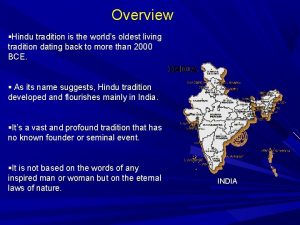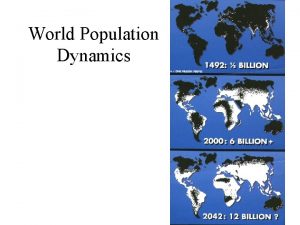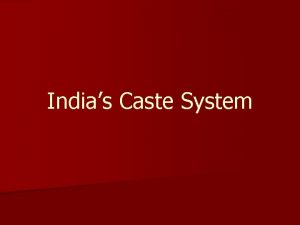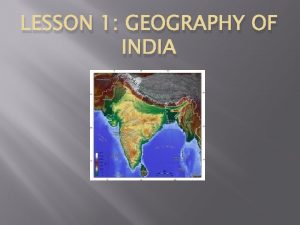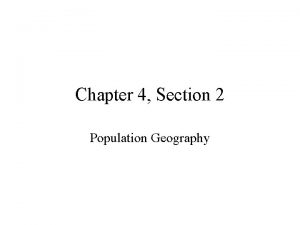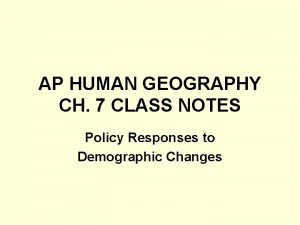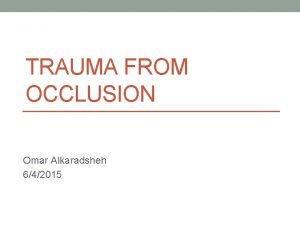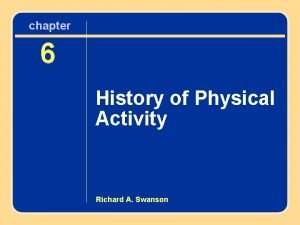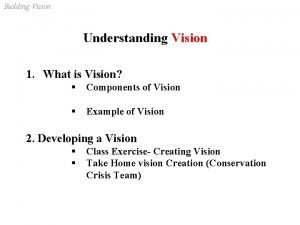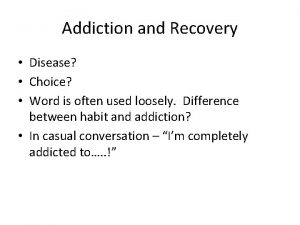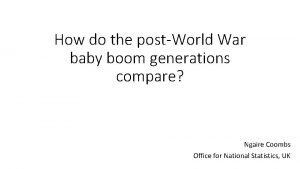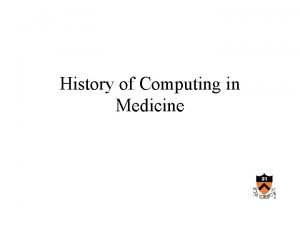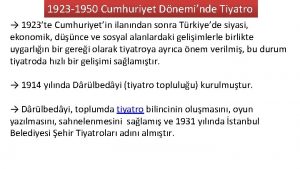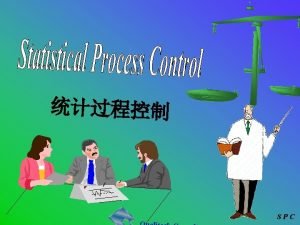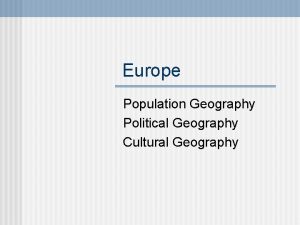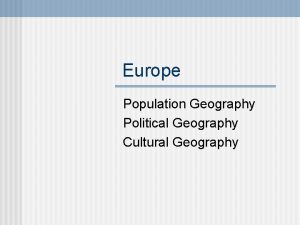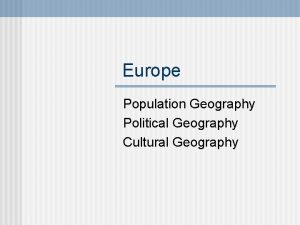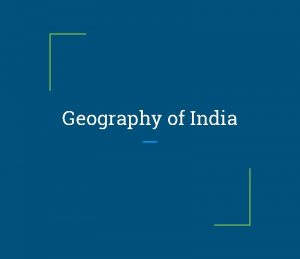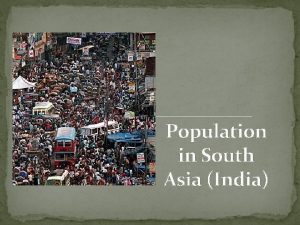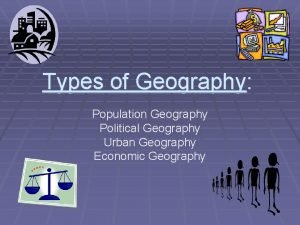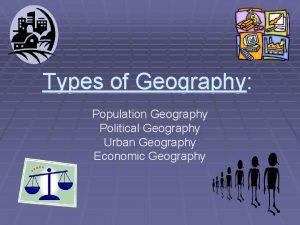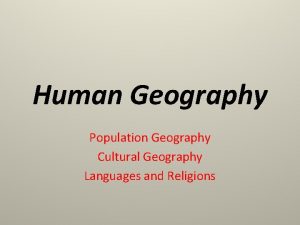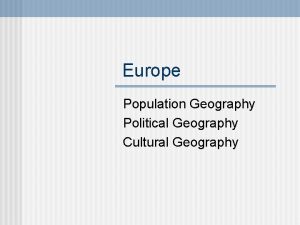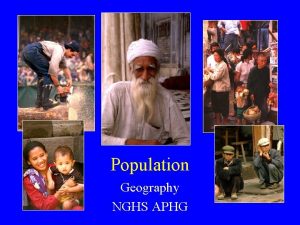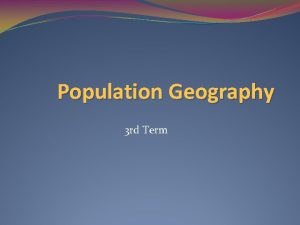POPULATION GEOGRAPHY In 1950 India had a population

















































- Slides: 49

POPULATION GEOGRAPHY

In 1950, India had a population of only 350 million people – 50 years later it had passed 1 Billion population!

During the 20 th Century, the world’s population grew at a rate never before experienced. Every year the world’s population grows by more than 77 million. This will continue as a relatively large proportion (approx. 28%) of the world’s population is under the age of 15 years. This leads to continued growth, even as fertility rates continue to decline.

World Population Growth – Adding Billions World Population When Reached How long did it take? 1 Billion 1804 Around 2 million Years 2 Billion 1930 130 Years 3 Billion 1960 30 Years 4 Billion 1974 14 Years 5 Billion 1987 13 Years 6 Billion 1999 12 Years 7 Billion 2011 12 Years



Can these trends continue? Obviously not. There are now signs to show that the explosive growth in human numbers will be followed by a significant slowdown in the rate of increase and that the world’s population will actually stabilise late in the 21 st Century.

However, even if the rate of growth stabilises or declines in the years to come, there still may be 9 Billion people living on the planet before 2050.

Many experts are concerned about the size of this increase. They fear that the addition of another 3 billion people will degrade and even overwhelm the earth’s biophysical environment: the land’s foodproducing capacity and the other natural resources on which all life depends.

They are also concerned that meeting the energy needs of the growing population will accelerate the rate of climate change. This will especially be the case if alternatives to the burning of fossil fuels are not developed.

Others believe that the earth’s population should be seen as a valuable resource. They claim that technology will enable humans to cope with the problems that will result from the population increase.

The Global Pattern of Population Increase

* Each grid square = 1 million people.

1. Approximately what percentage of the world’s population are from Asia? 1. Which group would include Australia’s population?

Click the link to go to Total Population Graphs http: //POPULATION GRAPHS - By Country Click the link below to go to Population Growth Graphs http: //Population Growth Rates - By Country



Identify 5 differences in the most populous countries between 2014 and 2050

Identify 5 interesting points about fertility rates that can be inferred from these two tables.

Write a quality paragraph that summarises the data shown in the above table.

https: //www. youtube. com/watch? v=e. UD 4 y 74 YDik Population Movements Type, volume, direction Rural to urban, labour, refugee

POPULATION MOVEMENTS Population Movement terms Define: • migration – the act or process of moving from one place to another with the intention of staying at the destination permanently or for a long period of time • immigration – the movement of people into an area • emigration – the movement of people out of an area • internal migration – population movements within a country • international migration – population movements across national boundaries • voluntary migration – when people move to improve their economic and social wellbeing and / or gain personal freedom • forced migration – from circumstances beyond the control of the individual e. g. natural disasters, civil unrest, war that initiate large scale population movement

International Migration International migration is a global phenomenon that is growing in size, complexity and impact. Migration is both a cause and an effect of development processes, it’s an intrinsic feature of our ever globalizing world.

Visualising World Population Density

Interactive World Population Density Map

World Population Density

Australia number 55 With 24 million


POPULATION MOVEMENTS Features of movement: Globalisation has lead to ü lncrease in volume of migration in all regions ü growing diversity in the type of migration (labour, refugee, family reunion etc) ü increasing proportion of women in all types of migration ü increasing international mobility of highly qualified workers ü movements associated with economic and social change in newly industrialised countries

POPULATION MOVEMENTS International Movements Movement of people from one continent to another and from one country to another has occurred throughout history. These movements are now part of a global process that is reshaping societies and cultures. Most movements are associated with economic, political and cultural links being formed between countries due to globalisation. Migrant and ethnic diversity in countries are forces for social and cultural change. Today more than 120 million people live outside their country of birth. Some countries are largely the product of immigration e. g. USA, Canada, Australia and New Zealand. Their population consist mainly of European immigrants and their descendants. The indigenous peoples that once occupied these lands have been dispossessed and remaining populations are marginalized and discriminated against. These countries have seen a change in source of immigration with more people coming to Australia, New Zealand Canada from Asia; and coming to USA from Mexico, South America and the Caribbean.

POPULATION MOVEMENTS 1. Make a list of the push and pull factors that make people decide to leave the place they are living. 2. http: //differencedifferently. edu. au/mapping_diversity/part_2 a_1. php 3. Identify some of the 'pull' factors that make people want to move to Australia.

http: //www. iom. int/world-migration Patterns and Trends • http: //www. iom. int/world-migration


POPULATION MOVEMENTS International Movements: where are they from and where are they going CENTRAL AND SOUTH AMERICA • An exodus of refugees from Cuba and Haiti to USA. • Labour migrations (often illegal) from Mexico, Jamaica and other Caribbean countries to USA. AFRICA • Large-scale migration initiated by climate disasters, conflict, civil disorder and famine. • Other major movements are labour migrations for plantations and mines. • Some traditional seasonal migration continues in Sub-Saharan Africa. ASIA • Large-scale international movements are common. Iran, Pakistan host Afghan refugees, India has many immigrants from Sri Lanka, Nepal and Bagladesh. • Emerging economic powers of South East Asia also attract thousands of foreign workers (often illegal).

POPULATION MOVEMENTS International Movements cont… THE MIDDLE EAST • Mostly foreign labour for oil revenue. Guest workers on short-term contract recruited in large numbers from other Arab states, India, Sri Lanka, Bangladesh and Philippines. • Turkey – a lot of emigration in past and now family reunion emigration. Now immigration from other Eastern European Muslims. EUROPE • Population movements in Europe have changed dramatically due to the collapse of communism and conflict in former Yugoslavia.

POPULATION MOVEMENTS International Movements cont… TYPES OF INTERNATIONAL MOVEMENTS RESETTLEMENT MIGRATION - When people choose to migrate and settling permanently in another country for a better quality of life for themselves and their children. Others seek family reunion with previous immigrants. - A growth in the number of professionals and skilled workers migrating permanently e. g. Dr’s from Malaysia coming to Australia.

POPULATION MOVEMENTS International Movements cont… CONTRACT MIGRATIONS Contracted for employment for a specific period of time. Income often sent home to worker’s family. 1. Guest Workers - In some countries there are more jobs than people willing or able to work. Labour shortages are made up by allowing guest workers into the country for a specified period of time. - Oil-rich countries of Middle East (e. g. Saudi Arabia, Libya and Kuwait host more than 4. 5 million foreign workers. - Sometimes these guest workers have minimal rights and poor living conditions and subject to exploitation and abuse (esp women).

POPULATION MOVEMENTS International Movements cont… CONTRACT MIGRATIONS cont… 2. Business Migration - Due to globalisation and the growth of TNCs, there has been a growth in international movements of highly qualified executives and professionals. 3. Student Migrations - Large number of students from both developing and developed countries now study at schools and Universities throughout the world.

POPULATION MOVEMENTS International Movements cont… REFUGEES (Forced Migrations) People driven from their homeland due to war, famine, natural disasters or religious, political or ethnic persecution. United Nations (UN) defines a refugee as “being a person who cannot return to their country of origin without risking serious harm because of a well-grounded fear of persecution based on their race, religion, nationality or political views”. - The number of refugees has growth substantially since the mid 1970 s after more than 2 million refugees from Vietnam, Cambodia and Laos fled mostly to Australia, USA, Canada and Western Europe. - Since then we have seem large movements out of the Middle East , South America and Africa and Eastern Europe. - The number of refugees worldwide is estimated to be over 22 million.

Internal Migration Internal migration is the movement of people from one defined area to another within a country.

POPULATION MOVEMENTS RURAL-URBAN MIGRATIONS - The drift to cities (rural-urban migration), especially in the developing world, has led to rapid population growth in the size of cities and the proportion of the population living in urban area (towns and cities). - Start of C 20 th only 14% of world population lived in urban places, by the 2025 it is estimated there will be more than 60%. - ‘Push” Factors include famine, war & civil unrest, rural poverty, landlessness, land degradation & mechanisation, lack of medical facilities, lack of educational opportunity, and climate disasters. - ‘Pull” Factors include: employment opportunities, hope of a better standard of living, better access to services such medical facilities, educational opportunities, and entertainment.

Settlement patterns • State by state population numbers • http: //mccrindle. com. au/Infographic/06 -2012/Australian-Population. Census-Results_2012_Mc. Crindle-Research-infographic. pdf

POPULATION MOVEMENTS INTERNAL MIGRATIONS cont… POPULATION MOVEMENTS RELATED TO CHANGING PATTERNS OF WORK • Population initiatives are also initiated by changes in the patter of economic activity. • Developed world – decline in manufacturing employment due to old industrial areas unable to compete with newer plants in developing countries. Sometimes displaced workers will move to follow the work opportunities. • A growth in services sector have led to changes in distribution of the workforce. MOVEMENTS WITHIN CITIES • Older industrial areas that were once in inner city areas have relocated into the edges of cities. This contributed to suburbanisation where people move from inner city to suburbs at the city’s outskirts leading to urban sprawl. • Gentrification and consolidation have countered this trend and people are now moving back into redeveloped inner city areas with medium and higher density housing. SEASONAL MOVEMENTS • Related to work and leisure e. g. fruit pickers, ski resort workers, tourism workers.

POPULATION MOVEMENTS INTERNAL MIGRATIONS cont… COUNTER-URBANISATION - In developed world urbanisation and urban growth have slowed and more counter-urbanisation taking place - People choosing to leave large urban areas for smaller communities usually for quality of life reasons. - Associated with changes in economic activities not tied to urban areas e. g. high tech manufacturing and service industries (like tourism). People can work from home or can commute longer distances due to better transport technologies. - With ageing populations, more retirees not tied to large urban areas. http: //evocities. com. au/

POPULATION GEOGRAPHY TERMS http: //bit. ly/1 Jxcfrr

ISSUES ARISING FROM THE CHANGING SIZE AND DISTRIBUTION OF POPULATION ² Global Inequalities ² World Food Supply ² Impacts on the Environment ² Landlessness ² Employment

ISSUES ARISING FROM THE CHANGING SIZE AND DISTRIBUTION OF POPULATION HANDOUTCloze Activity

ISSUES ARISING FROM THE CHANGING SIZE AND DISTRIBUTION OF POPULATION Cloze Activity WORD BANK 85 agricultural services 9 producing ownership population waste Environmentalists degradation innovations employment goods underemployment malnutrition biophysical migration economists 7 developing environmental distribution alternatives energy

ISSUES ARISING FROM THE CHANGING SIZE AND DISTRIBUTION OF POPULATION Create a Concept Map (Mind Map) with theme: “Issues Arising From The Changing Size & Distribution Of Population - Impacts on The Environment”
 Before she went to work she had eaten breakfast
Before she went to work she had eaten breakfast I had eaten my breakfast
I had eaten my breakfast Hindu population outside india
Hindu population outside india India population
India population Caste population in india
Caste population in india Total disabled population in india
Total disabled population in india Population explosion
Population explosion Indian caste system names
Indian caste system names Classical india geography
Classical india geography Lesson 1 physical geography of india
Lesson 1 physical geography of india Chapter test a chapter 4 population ecology answer key
Chapter test a chapter 4 population ecology answer key Section 1 population dynamics
Section 1 population dynamics Population ecology section 1 population dynamics
Population ecology section 1 population dynamics Population ecology section 1 population dynamics answer key
Population ecology section 1 population dynamics answer key Chapter 4 section 2 population geography
Chapter 4 section 2 population geography Eugenic population policies ap human geography
Eugenic population policies ap human geography Frq format ap human geography
Frq format ap human geography 5 themes of geography ap human geography
5 themes of geography ap human geography Ap human geography political geography test
Ap human geography political geography test Coğrafya hocası.com
Coğrafya hocası.com Cos 1950°
Cos 1950° Trauma from occlusion sequence
Trauma from occlusion sequence 1950 luvun kirjallisuus
1950 luvun kirjallisuus Frank stella
Frank stella Pop art 1960
Pop art 1960 1950 pop art
1950 pop art Lbb 1950/10
Lbb 1950/10 Poems from 1900 to 1950
Poems from 1900 to 1950 Moda italian
Moda italian Welches programm
Welches programm Popular music 1950
Popular music 1950 Between 1950 and 2000, physical activity professions
Between 1950 and 2000, physical activity professions What is vision
What is vision Festinger schachter and back (1950)
Festinger schachter and back (1950) Adorno et al
Adorno et al Autumn rhythm (number 30) 1950
Autumn rhythm (number 30) 1950 Pop art 1950 60
Pop art 1950 60 50-luvun muoti miehet
50-luvun muoti miehet 1973 türkiye güzeli beyhan kıral
1973 türkiye güzeli beyhan kıral What groups were experiencing poverty in the 1950’s?
What groups were experiencing poverty in the 1950’s? Baby boom 1950
Baby boom 1950 Computers in the 1950
Computers in the 1950 Automania definition 1950
Automania definition 1950 Emilio pucci 1950
Emilio pucci 1950 50s music trivia questions and answers
50s music trivia questions and answers Akta keterangan 1950
Akta keterangan 1950 Chiến thắng biên giới thu đông 1950 violet
Chiến thắng biên giới thu đông 1950 violet 1950 school punishments
1950 school punishments Cumhuriyet dönemi'nde tiyatro 1923 1950
Cumhuriyet dönemi'nde tiyatro 1923 1950 1980-1950
1980-1950


